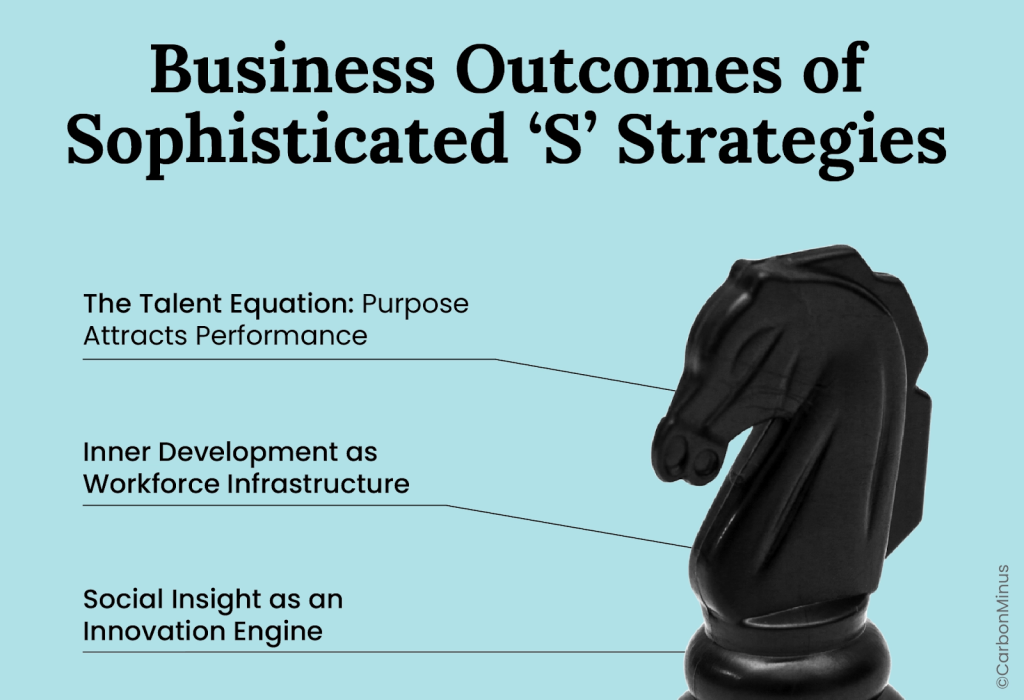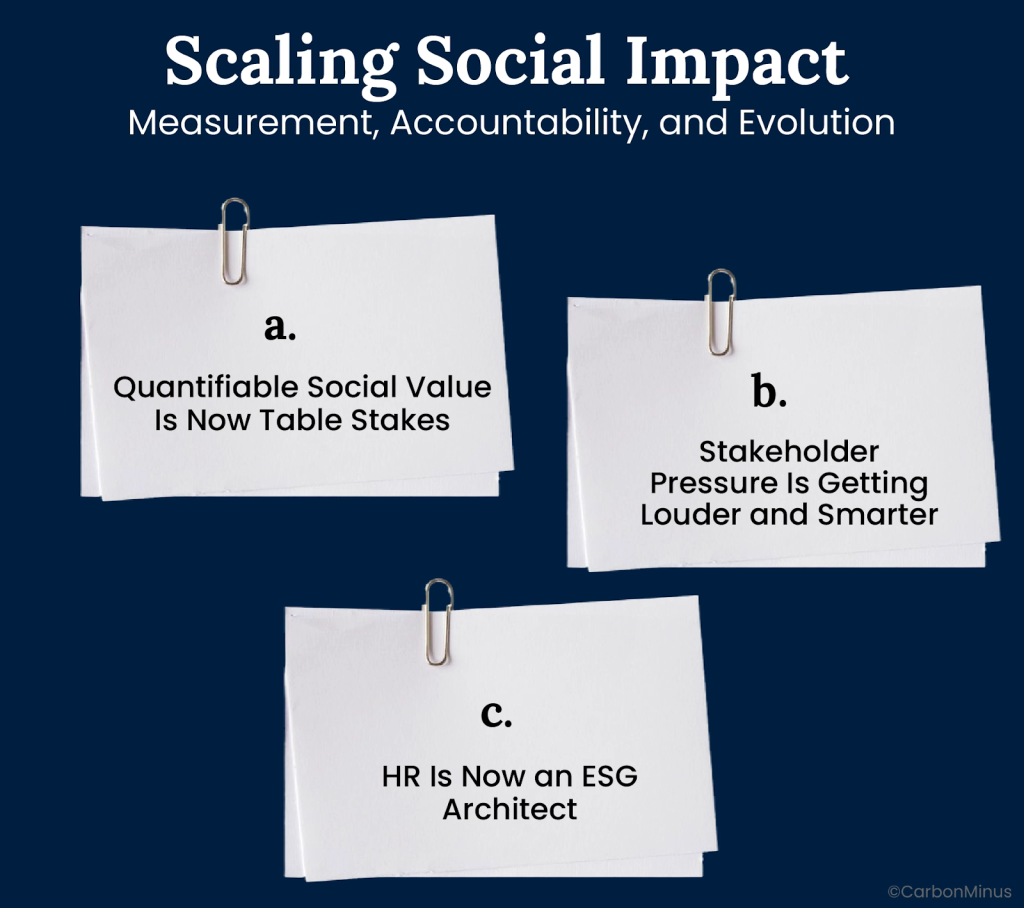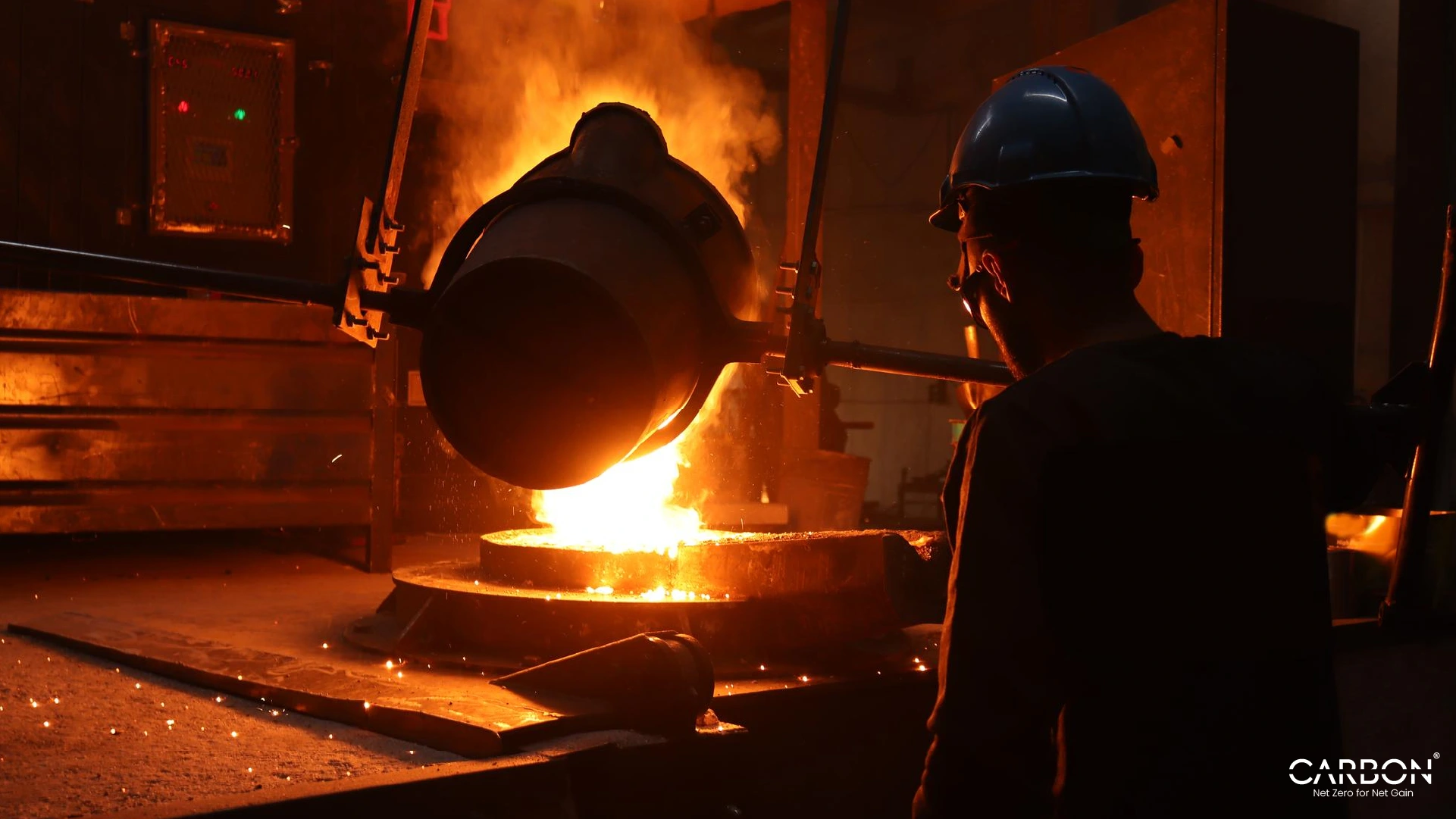Key Takeaways
- CSRD and ESRS make social data mandatory.
- DEI, wellbeing, and equity now impact ROI.
- Talent chooses employers with aligned values.
- HR is now central to ESG execution.
- Social intelligence builds resilience and trust.
Sustainability used to mean carbon, energy, emissions. That’s changing fast.
In 2025, it’s also about people—how we work, who we hire, what we stand for, and how we show up in the communities we operate in.
The “S” in ESG isn’t the quiet middle letter anymore. It’s front and center. Not because the rules say so, although CSRD and other frameworks are dialing up pressure. But because the business case has finally caught up.
Social intelligence now shapes everything: brand trust, talent retention, resilience under pressure, and license to operate. Companies can’t afford to treat it as philanthropy or corporate fluff.
It’s infrastructure. It’s strategy.
This blog unpacks how forward-looking organizations are turning the “S” into a source of innovation, loyalty, and performance. Because in this new ESG landscape, the companies that know how to treat people right, inside and outside the walls, are the ones winning.
Redefining the ‘S’: Four Pillars of Strategic Social Performance
For years, the “S” in ESG lagged behind its more measurable siblings. That’s no longer the case. In 2025, social performance is front-line strategy and these are the four areas where leading companies are getting it right.

A. DEI as a Catalyst for Innovation and Performance
Diversity used to be seen as a checkbox. Now, it’s fueling how companies grow.
Inclusive teams approach problems differently. They pull from a wider range of lived experience and it shows, especially in product design, leadership decisions, and how they enter new markets.
McKinsey’s data backs it up: companies with diverse executive teams are significantly more likely to outperform financially. And BCG found that organizations with varied management report nearly 20% higher revenue from innovation.
B. Proactive Wellbeing as a Productivity and Resilience Engine
Burnout isn’t just a health issue. It’s also a business risk.
Some companies are still trying to fix it with benefits. The smarter ones are building systems that prevent it: ethical use of people data, flexible workloads, support that shows up early.
Deloitte’s 2024 findings? Companies that put real money into mental health are seeing strong returns—$4 to $5 for every $1 spent.
Firms that moved early with internal wellbeing dashboards saw a clear drop in attrition, up to 15%, and fewer unplanned absences. Not perfect, but a big step toward stability.
C. Supply Chain Equity: From Policing to Partnership
Audits and codes of conduct used to be the go-to tools for managing supply chain risks. They still have a role, but they’re no longer enough.
More companies are taking a different approach: building actual partnerships with their suppliers. Not just asking for compliance, but sharing standards, investing in training, and supporting long-term improvements in working conditions.
This shift isn’t about softening expectations. It’s about improving outcomes, especially in regions where volatility is high and trust takes time to earn.
The International Labour Organization has shown that when suppliers are treated as partners, not just vendors, the result is better working conditions, more consistent output, and higher productivity sometimes by as much as 20%.
D. Strategic Community Integration: Place-Based Value, Not PR
Community engagement used to sit in the PR folder. Now it sits in strategy decks.
Leading companies are linking local impact to core capabilities—healthcare, education, logistics, access. Retailers are using last-mile infrastructure to address urban food deserts. Tech companies are bringing digital access to underserved schools.
Over 70% of consumers prefer to support companies they see investing in social progress (Porter Novelli, 2024). That’s not sentiment. That’s spend.
Social license to operate isn’t given, it’s earned. And companies who treat place-based strategy seriously are earning loyalty that sticks.
Business Outcomes of Sophisticated ‘S’ Strategies
Treating social performance as strategy, not optics, is good for communities and employees. While also delivering clear business results.
From hiring to innovation to workforce resilience, the companies investing in the “S” are outperforming those that don’t.

A. The Talent Equation: Purpose Attracts Performance
For a growing share of the workforce, especially Millennials and Gen Z, paychecks aren’t enough. They want to work for companies that reflect their values.
In 2025, that’s not a cultural preference. It’s a competitive edge.
A recent LinkedIn Global Talent Trends report found that over 65% of candidates won’t take a job if the company has a poor track record on social issues. Culture, purpose, and transparency now rank among the top three reasons people choose a role and stay.
Firms that lead with strong social metrics are attracting better candidates, reducing churn, and strengthening employer brands that are hard to fake.
B. Inner Development as Workforce Infrastructure
The skills that matter most right now, adaptability, emotional intelligence, resilience, used to be called “soft.” They’re not soft anymore. They’re survival tools.
Frameworks like the Inner Development Goals (IDGs) are gaining traction as companies look to prepare people for fast-changing demands, not just train them for tasks. IKEA has built internal learning programs that focus as much on empathy and complexity-thinking as on traditional skills.
And it’s working. The World Economic Forum continues to rank critical thinking, flexibility, and curiosity as top future-proof capabilities. These aren’t nice-to-haves. They’re what hold teams together during disruption—and unlock leadership potential most orgs overlook.
C. Social Insight as an Innovation Engine
Understanding unmet social needs isn’t just a moral imperative, it’s a business opportunity.
Companies are using ESG data and human-centered design to build new offerings: products for underserved communities, services that address equity gaps, platforms that extend access to healthcare or education.
And with AI tools scaling faster than regulation, many are deploying machine learning to tackle complex social challenges—everything from elder care logistics to predictive workforce access models.
The “AI for Social Good” market is expanding rapidly, with a projected 20%+ CAGR through 2027. It’s not just philanthropy. It’s product-market fit in a world of evolving expectations.
Scaling Social Impact: Measurement, Accountability, and Evolution
Companies are being asked tougher questions about social impact and this time, the answers have to be backed by data.
Social metrics used to be internal. They lived in HR dashboards or annual reports. In 2025, that’s changed. With CSRD and ESRS in force, thousands of companies are now required to disclose everything from workforce composition to value chain labor practices.
These aren’t soft metrics. They sit beside revenue and cost data, and they’re being used to evaluate risk and performance.
And the shift is cultural too. More companies are linking workforce wellbeing, inclusion, and equity directly to business outcomes and showing those links in investor briefings, not just CSR decks.

A. Quantifiable Social Value Is Now Table Stakes
Workforce diversity. Pay equity. Wellbeing scores. Supplier inclusion. These aren’t feel-good metrics anymore, they’re business disclosures.
Under the CSRD’s social standards (ESRS S1–S4), around 50,000 companies are now required to publish detailed data on topics like workforce composition, fair wages, and human rights in supply chains.
And the shift isn’t just legal. It’s cultural. Since 2020, the number of large companies adopting integrated reporting frameworks, where social and human capital data sit next to financial results, has jumped by over 40%.
When stakeholders can see these numbers, they start using them. Investors. Customers. Employees. The whole ecosystem.
B. Stakeholder Pressure Is Getting Louder and Smarter
In the past, social expectations came in the form of quiet pushback—internal discussions, media stories, the occasional petition. That’s not the case anymore.
Employees, customers, and shareholders are raising the volume. They’re also getting more organized.
In the last two years, shareholder proposals on human capital, supply chain ethics, and DEI have surged in number and in the level of support they receive. Internal forums, social platforms, and town halls are now hot spots for surfacing concerns that directly influence strategy.
And companies that respond with more than statements who bring transparency and accountability early are finding they can turn potential criticism into meaningful alignment.
C. HR Is Now an ESG Architect
The role of HR has expanded. What used to be seen as administrative, recruiting, benefits, training, is now central to delivering on ESG strategy.
In leading companies, HR teams are helping shape how equity and inclusion show up in real systems: how performance is evaluated, how leadership is developed, how decisions are made. They’re working alongside finance, legal, and operations to ensure that values don’t just live in policies, but in practice.
And they’re building capabilities that weren’t on the radar five years ago, like designing frameworks for measuring social impact or managing stakeholder expectations around labor rights and pay equity.
Social Intelligence as Competitive Currency
Companies used to talk about people as assets. In 2025, the best ones are backing that up with strategy and infrastructure.
Social intelligence is a measurable capability. The ability to engage communities, support workforce wellbeing, foster equity across supply chains, and align action with values is now directly linked to growth, resilience, and long-term performance.
The numbers are pointing in one direction.
- 65%+ of employees won’t join a company that underperforms on social issues.
- 50,000 companies are reporting under CSRD’s social standards.
- ESG-driven innovation, especially where social needs meet technology, is expanding at double-digit growth rates.
The organizations pulling ahead are the ones treating “S” like infrastructure, not initiative. They’re embedding it into hiring, product development, capital strategy, and operations.
Because in a world where complexity is constant and trust is fragile, the companies that lead with human clarity, along with efficiency, are the ones that last.
Why is the ‘S’ suddenly getting so much attention in ESG?
Because it’s no longer optional or vague. Regulations like CSRD now require companies to report on workforce composition, pay equity, and supply chain labor practices. At the same time, investors, employees, and consumers are making decisions based on how companies treat people, not just how they report emissions.
What’s actually included under the ‘S’?
It covers a wide spectrum: diversity and inclusion, employee wellbeing, labor rights across the supply chain, community engagement, human rights, and now even digital wellbeing. Under CSRD, these are defined through ESRS S1 to S4, covering your workforce, your suppliers’ workers, affected communities, and end-users.
Is social impact really measurable?
Yes and it has to be. Metrics like pay equity ratios, wellbeing scores, diversity breakdowns, and safe labor conditions are all being audited. What used to be tracked quietly is now being disclosed publicly.
How does social performance tie to business performance?
The link is getting clearer every year. Companies with strong DEI and wellbeing strategies see lower attrition, faster innovation, and stronger brand loyalty. Shareholder support for social proposals is also rising, so alignment isn’t just ethical, it’s protective.
Who’s responsible for the ‘S’ inside the company?
It’s no longer just HR or sustainability. Social impact cuts across functions: finance (disclosures), legal (compliance), ops (supplier practices), and comms (transparency). HR plays a bigger role than ever—but they’re not doing it alone.




